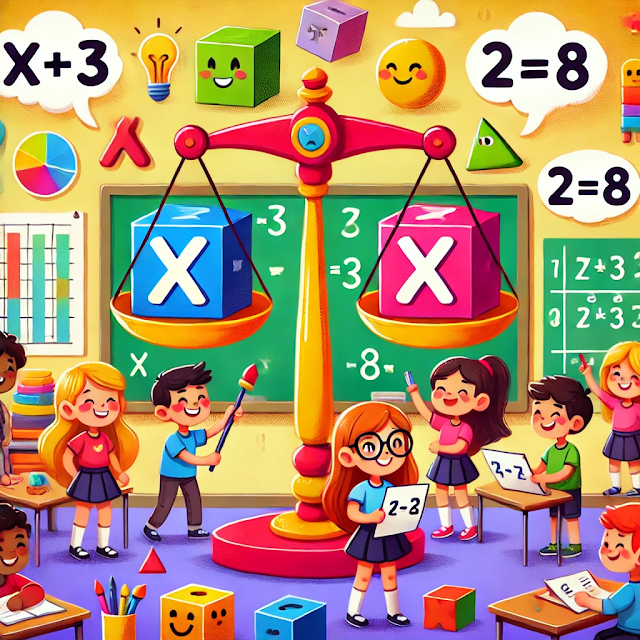Topic: Solving Simple Equations
Objective: By the end of the lesson, students will understand basic
algebraic concepts and solve simple equations using hands-on and creative
activities.
Lesson Outline
|
Bloom's Level |
Activity |
Time |
|
1. Remembering |
Flashcard Definitions |
10 min |
|
2. Understanding |
Equation Building with Blocks |
10 min |
|
3. Applying |
Balancing Equations |
10 min |
|
4. Analyzing |
Equation Sorting |
10 min |
|
5. Evaluating |
Peer Problem-Solving |
10 min |
|
6. Creating |
Algebra Art Puzzle |
10 min |
Activity Details
1. Remembering: Flashcard Definitions
- Materials:
Flashcards with terms (e.g., “variable,” “equation,” “solution”) and
definitions.
- Instructions:
- Display
flashcards with terms on one side and definitions on the other.
- Read
aloud and have students guess the term.
- Use
a quick match-the-definition game to reinforce understanding.
2. Understanding: Equation Building with Blocks
- Materials:
Colored blocks, whiteboard.
- Instructions:
- Assign
colors to represent variables and numbers (e.g., blue block = x, red
block = 1).
- Show
an equation (e.g., x + 2 = 5).
- Students
build the equation with blocks, then solve by rearranging.
3. Applying: Balancing Equations
- Materials:
Balance scale, weights (blocks or coins).
- Instructions:
- Use
the balance scale to represent an equation (e.g., x + 3 = 7).
- Place
weights on one side to represent constants and variables.
- Students
add/remove weights to balance and find the value of x.
4. Analyzing: Equation Sorting
- Materials:
Cards with equations of different types (addition, subtraction, etc.).
- Instructions:
- Distribute
equation cards.
- Students
sort them into categories based on operations involved.
- Discuss
the approach for solving each type.
5. Evaluating: Peer Problem-Solving
- Materials:
Whiteboard or worksheets.
- Instructions:
- Students
write their own equations (e.g., 2x + 4 = 10).
- Exchange
equations with a partner and solve.
- Provide
feedback on logic and steps.
6. Creating: Algebra Art Puzzle
- Materials:
Chart paper, markers, art supplies.
- Instructions:
- Students
design creative puzzles or riddles that include simple equations.
- Decorate
with drawings or patterns.
- Share puzzles with peers to solve.
Practical Usage of Algebra for a Common Man: Real-Time Examples
Algebra isn't just for the classroom—it's a powerful tool used in everyday problem-solving and decision-making. Here are some real-time examples of how a common person can use algebra in daily life:
1. Budgeting and Finances
- Scenario: You have a monthly budget of $2,000. After paying rent ($1,200) and utilities ($300), you want to determine how much you can spend on groceries and entertainment.
- Algebra Application:
Let represent the amount left for groceries and entertainment.
Equation:
Solve for : .
Use: Helps allocate your budget wisely.
2. Home Renovation or Interior Design
- Scenario: You’re buying tiles for a room that is 12 feet by 10 feet. Each tile covers 2 square feet, and you need to calculate how many tiles to purchase.
- Algebra Application:
Let be the number of tiles needed.
Equation:
Solve for : .
Use: Ensures you buy the correct amount of materials.
3. Cooking and Recipe Adjustments
- Scenario: A recipe serves 4 people, but you need to cook for 6 people. The recipe calls for 2 cups of flour, and you need to adjust the quantity.
- Algebra Application:
Let represent the amount of flour for 6 people.
Equation:
Solve for : .
Use: Helps scale up recipes accurately.
4. Travel and Distance Calculations
- Scenario: You plan to drive 300 miles. Your car uses 1 gallon of fuel for every 25 miles. You need to calculate how many gallons of fuel are required.
- Algebra Application:
Let be the gallons of fuel needed.
Equation:
Solve for : .
Use: Prepares you for fuel expenses and stops.
5. Fitness and Diet Tracking
- Scenario: You consume 2,500 calories daily and want to reduce to 2,000 calories per day. If you reduce your intake by the same amount across 3 meals, how much should you reduce per meal?
- Algebra Application:
Let be the reduction per meal.
Equation:
Solve for : calories.
Use: Helps plan meals for weight management.
6. Determining Loan Payments
- Scenario: You take a loan of $10,000 with an annual interest rate of 5% for 3 years and need to calculate monthly payments.
- Algebra Application:
Use the formula , where:- = Monthly payment
- = Loan amount
- = Monthly interest rate (5% ÷ 12 = 0.0042)
- = Total number of payments (3 years × 12 months = 36)
Solve for using algebra to plan finances effectively.
7. Shopping Discounts
- Scenario: A store offers 20% off on an item priced at $50. You want to know the discounted price.
- Algebra Application:
Let be the discounted price.
Equation: .
Solve for : .
Use: Saves money by calculating discounts accurately.
8. Work Projects or Business
- Scenario: A delivery service charges $5 for the first mile and $2 for each additional mile. You want to calculate the cost for a 10-mile delivery.
- Algebra Application:
Let represent the total cost.
Equation: .
Solve for : .
Use: Helps estimate service costs for budgeting.
By using algebra in these real-life examples, a common person can make better decisions, save money, and plan efficiently!
Prompt for the above content:
Develop a 60-minute lesson plan for teaching algebra for
middle school using Bloom's Taxonomy. Each level should include a specific
activity with clear instructions and examples. Make the activities hands-on and
fun, using materials like flashcards, blocks, and art supplies also give a
catchy picture to attract the learners. Also give me practical usage of the
concept for a common man with real-time examples.






No comments:
Post a Comment